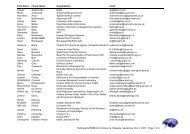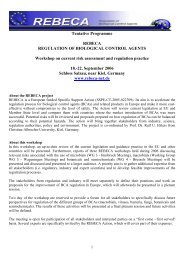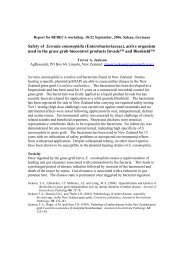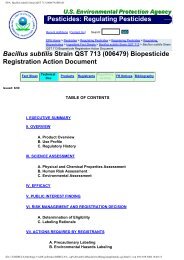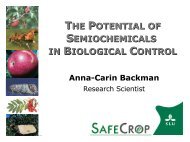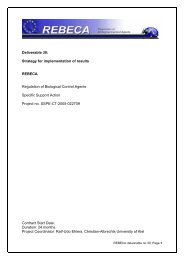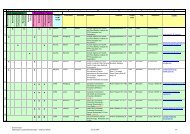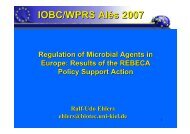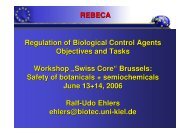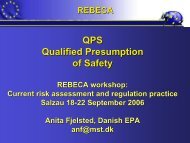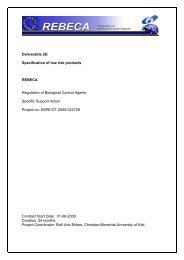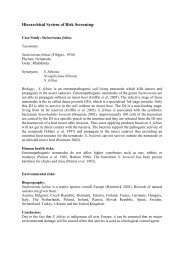Regulatory information Ampelomyces quisqualis - AQ 10 ... - REBECA
Regulatory information Ampelomyces quisqualis - AQ 10 ... - REBECA
Regulatory information Ampelomyces quisqualis - AQ 10 ... - REBECA
Create successful ePaper yourself
Turn your PDF publications into a flip-book with our unique Google optimized e-Paper software.
<strong>Regulatory</strong> <strong>information</strong><br />
<strong>Ampelomyces</strong> <strong>quisqualis</strong> - <strong>AQ</strong> <strong>10</strong><br />
Sergio Franceschini, Intrachem<br />
<strong>Ampelomyces</strong> <strong>quisqualis</strong> isolate M-<strong>10</strong> is a naturally occurring hyperparasite of powdery mildews.<br />
This parasitism reduces growth and may eventually kill the mildew colony. The mycoparasite is not<br />
restricted to powdery mildews. In vitro work indicates that it can be parasitic on Botrytis cinerea<br />
Pers. Ex. Fr., Alternaria solani (Ell. & Mart.) Sor., Colletotrichum coccodes (Wallr.) Hughes, and<br />
Cladosporium cucumerinum Ell. & Arth (Jarvis & Slingsby, 1977) There is no <strong>information</strong><br />
indicating that A <strong>quisqualis</strong> shows infectivity or pathogenicity to any organisms beyond this<br />
relatively narrow taxonomic range of fungal pathogens. Indeed, its life history strategy as a<br />
hyperparasite, would tend to preclude a wide host range.<br />
It infects and forms pycnidia (fruiting bodies) within powdery mildew hyphae, conidiophores<br />
(specialised spore-producing hyphae) and cleistothecia (closed fruiting bodies of powdery<br />
mildews). Having penetrated into the mildew hyphae, the fungus produces pycnidia, in which form<br />
the pathogen can survive adverse periods e.g. winter, in and around the host plants of the mildew<br />
fungi. The pycnidia produce spores, which require favourable conditions for successful germination<br />
e.g. in terms of temperature, moisture and in particular the presence of the appropriate host. Overwintering<br />
pycnidia can also be produced saprophytically in vascular plants e.g. in mildewed clover<br />
leaves and in cucumber leaves (Yarwood, 1939). The infectivity of the spores produced by the<br />
pycnidia rapidly diminishes under field conditions (e.g. 24 to 48 hours), although this can be<br />
extended under appropriate conditions.<br />
Sundheim and Krekling (1982) demonstrated that A. <strong>quisqualis</strong> produced specialised appressoriumlike<br />
penetration structures on powdery mildew. Penetration of the host cell was probably due to<br />
mechanical and enzymatic processes. Furthermore, enzymatic digestion played a major role in the<br />
invasion of the host cell and the destruction of cytoplasm. Invading hyphae penetrated the host cells<br />
through the septal pores of the host. Beuther et al (1981) studied the effects of extracts from the<br />
hyperparasite on growth, sporulation and conidial germination of the host. They found no evidence<br />
of toxin production.<br />
In terms of long-term exposure, the spores are unlikely to remain viable for long periods of time.<br />
Thus, for successful germination the spores need both favourable conditions (e.g. high humidity or<br />
moisture, temperature around 25 o C) and the presence of the host. Without the host, viability is<br />
rapidly lost e.g. within a few days. While the spores can survive for longer under appropriate<br />
conditions (low humidity or lack of moisture and low temperatures), these are unlikely to be the<br />
prevailing conditions at the time of application or at least for any prolonged period. However, the<br />
A. <strong>quisqualis</strong> pycnidia, which will be produced from the infected mildew, are more resilient and<br />
may persist in the environment for relatively long periods (at least into the next season). These in<br />
turn, may give rise to viable spores when conditions become favourable again.<br />
The toxicological profile of A. <strong>quisqualis</strong> is environmentally sound. The product shows no adverse<br />
effect on humans with no pathogenic or infective effects (acute or chronic) in the different routes of<br />
application (oral, dermal, inhalation), tested through experimental studies. No irritating or sensitizer<br />
effect on the tested animals and no genotoxicity or mutagenicity activity observed in vitro tests.<br />
Regarding the effect on non target organism, A. <strong>quisqualis</strong> shows very low toxicity to birds. No<br />
signs of infectivity or pathogenicity were observed in either of the two species tested.
The generated <strong>information</strong> indicates that A. <strong>quisqualis</strong> is of low toxicity to non-target organisms,<br />
aquatic organisms (fish and aquatic invertebrates) and honey bees. The results of the studies also<br />
showed no signs of any infectivity or pathogenicity to the organisms tested.<br />
These findings are consistent with the known mode of action of this fungal parasite, invading the<br />
mildew hyphae and penetrating the host cell walls, probably by enzymatic action, resulting in slow<br />
death of the host. There is no evidence of any toxin production, which could in turn have effects on<br />
other, non-target organisms. In addition, these findings are consistent with the life history strategy<br />
of a hyperparasite, having a relatively narrow host range, which in this case is restricted to powdery<br />
mildews as well as some other fungal species. On this basis, it would be unlikely to find infectivity<br />
or pathogenicity extending to other, non-host groups particularly those that are taxonomically<br />
unrelated e.g. birds, mammals, fish, aquatic invertebrates, algae, non-target arthropods and<br />
earthworms.<br />
One final consideration that needs to be taken into account, is that A. <strong>quisqualis</strong> is a naturally<br />
occurring organism that has been reported from most parts of the world. It is therefore likely that it<br />
is present at endemic levels wherever its hosts (the powdery mildews etc) are found with reasonable<br />
abundance/persistence. The only difference that the application of <strong>AQ</strong>-<strong>10</strong> is likely to make to this<br />
situation, is to the pattern of exposure i.e. short-term increases in the levels of exposure. Taking this<br />
into account, suggests that it is even less likely that there will be any significant risk to non-target<br />
organisms.<br />
<strong>AQ</strong>-<strong>10</strong>, is a water dispersible granule formulation containing the fungal hyperparasite A. <strong>quisqualis</strong><br />
isolate M-<strong>10</strong> as the active ingredient (58% viable spores and 42% inert co-formulants). The<br />
minimum viable spore content guaranteed is 5.0 x <strong>10</strong> 9 / gram of product.<br />
<strong>AQ</strong>-<strong>10</strong> should be applied 2 to 12 times a season at intervals of 7 to 14 days, depending on disease<br />
pressure. Earliest application is during shoot emergence, which depending on the region varies<br />
from March to April. It is applied at a rate of 35 - 60 g/ha in an adequate volume of water sufficient<br />
to have an good coverage of the vegetation. The optimum germination temperature is 25 o C and<br />
above 30 o C germination decreases and eventually stops at 37 o C.<br />
The advantage of using <strong>AQ</strong><strong>10</strong> is multiple. Firstly, the original mode of action, different from any<br />
other fungicide, reduced the risks of selection of resistant strains, mostly appearing with sterol<br />
inhibitors and strobilurins products. Another important factor is related to the fact that the product<br />
shows a higher activity than sulphur at lower temperatures, never determining phytotoxicity on the<br />
vegetation.<br />
On extensive field trials, <strong>AQ</strong><strong>10</strong> demonstrate also an activity against cleistothecia, over-wintering<br />
stage of the powdery mildew. Due to the absence of residue, National Authorities did not set any<br />
maximum level of residue (MLR) and consequently did not apply a post harvest interval (waiting<br />
period). Another relevant aspect is the no interference on the making and quality of musts and<br />
wines.<br />
For effective powder mildew control <strong>AQ</strong><strong>10</strong> can be applied alone, but it can also be included in IPM<br />
strategies, which provide for applications of both conventional agrochemicals and the bio control<br />
agents. <strong>AQ</strong><strong>10</strong> can be applied with any conventional spray equipment on grapes, strawberry,<br />
cucurbits, tomatoes, pepper and roses at low powdery mildew infestation levels.



